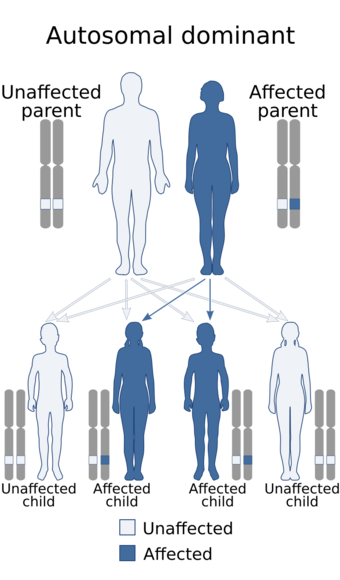Medicine:Quebec platelet disorder
| Quebec platelet disorder | |
|---|---|
| Other names | Factor V Quebec |
 | |
| Autosomal dominant is the manner of inheritance of this condition | |
Quebec platelet disorder (QPD) is a rare autosomal dominant bleeding disorder first described in a family from the province of Quebec in Canada.[1][2] The disorder is characterized by large amounts of the fibrinolytic enzyme urokinase-type plasminogen activator (uPA) in platelets.[3] This causes accelerated fibrinolysis (blood clot breakdown) which can result in bleeding.[2]
Presentation
Individuals with QPD are at risk for experiencing a number of bleeding symptoms, including joint bleeds, hematuria, and large bruising.[4]
Pathophysiology
The disorder is characterized by large amounts of uPA in platelets.[3] Consequently, stored platelet plasminogen is converted to plasmin, which is thought to play a role in degrading a number of proteins stored in platelet α-granules.[5] These proteins include platelet factor V, von Willebrand factor, fibrinogen, thrombospondin-1, and osteonectin.[3] There is also a quantitative deficiency in the platelet protein multimerin 1 (MMRN1). Furthermore, upon QPD platelet activation, uPA can be released into forming clots and accelerate clot lysis, resulting in delayed-onset bleeding (12-24hrs after injury).[6]
In 2010, the genetic cause of QPD was determined as a mutation involving an extra copy of the gene encoding uPA.[7] The mutation causes overproduction of uPA, an enzyme that accelerates blood clot breakdown.[2]
Diagnosis
Genetic testing is the only way to definitively diagnose QPD, as most other tests cannot confirm this diagnosis.[8] Methods include polymerase chain reaction or Southern blotting for the genetic sequence, or assays for platelet uPA levels or platelet granules.[8]
Treatment
Bleeding episodes are treated using antifibrinolytic medication, particularly tranexamic acid, to prevent fibrinolysis.[8]
History
The discovery was made by a team of doctors at McMaster University led by Dr. Catherine Hayward, a hematologist.[9]
References
- ↑ "An autosomal dominant, qualitative platelet disorder associated with multimerin deficiency, abnormalities in platelet factor V, thrombospondin, von Willebrand factor, and fibrinogen and an epinephrine aggregation defect". Blood 87 (12): 4967–78. 1996. doi:10.1182/blood.V87.12.4967.bloodjournal87124967. PMID 8652809.
- ↑ 2.0 2.1 2.2 "Quebec platelet disorder: features, pathogenesis and treatment". Blood Coagulation and Fibrinolysis 19 (2): 109–119. 2008. doi:10.1097/mbc.0b013e3282f41e3e. PMID 18277131.
- ↑ 3.0 3.1 3.2 Kahr, 2001
- ↑ McKay & Haq, 2004
- ↑ Sheth, 2003
- ↑ Diamandis & Adam, 2006
- ↑ "Persons with Quebec platelet disorder have a tandem duplication of PLAU, the urokinase plasminogen activator gene". Blood 115 (6): 1264–6. Feb 2010. doi:10.1182/blood-2009-07-233965. PMID 20007542.
- ↑ 8.0 8.1 8.2 Blavignac, Jessica; Bunimov, Natalia; Rivard, Georges; Hayward, Catherine P.M. (September 2011). "Quebec Platelet Disorder: Update on Pathogenesis, Diagnosis, and Treatment" (in en). Seminars in Thrombosis and Hemostasis 37 (6): 713–720. doi:10.1055/s-0031-1291382. ISSN 0094-6176. PMID 22102275. http://www.thieme-connect.de/DOI/DOI?10.1055/s-0031-1291382.
- ↑ "Gene that causes rare bleeding disorder identified". CTV.ca. 4 March 2010. http://www.ctvnews.ca/gene-that-causes-rare-bleeding-disorder-identified-1.488779.
External links
| Classification | |
|---|---|
| External resources |
 |

